Hadrian`s Wall

The Emperor Hadrian (ruled A.D. 117-138)
The Emperor Hadrian (re-enactment photo 2003)
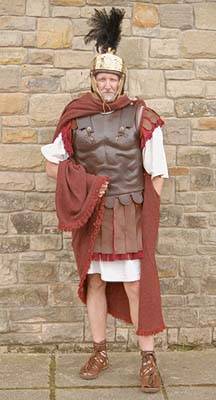
Although not the most Northernly Roman wall in Britain, Hadrian`s Wall is probably the most famous.
In 122 BC the Emperor Hadrian, realising that the task of subduing the Picts in the Far North would be a difficult and unprofitable one, decided to concentrate on keeping the Empire secure. He decreed that a wall should be built across the Northern frontier to "separate the Romans from the Barbarians," as one biographer in his day explained.
Constructed by members of three Auxiliary legions the wall took six years to complete and extended for eighty miles. Measuring eight to ten feet in width and reaching a height of fifteen feet it had over eighty forts ; a fort to every mile., each fort with "comforts" for a small garrison.
In between the forts, every one third of a mile, there were observation towers, and, in addition, to strengthen the might of the lesser forts, seventeen forts, each capable of accommodating between 500 - 1000 men. These were a mixture of infantry and cavalry troops drawn from countries as far afield as Spain, Germany and even North Africa.
Near each of these large forts a civilian settlement called a "vicus" sprang up.Here the soldiers were able to spend their money and slowly these settlements bcame permanent fixtures.
A wide ditch was dug out on the South side of the Wall to protect the troops from the always-rebellious Brigantes tribe. This ditch followed the earth banks.
Housesteads Fort
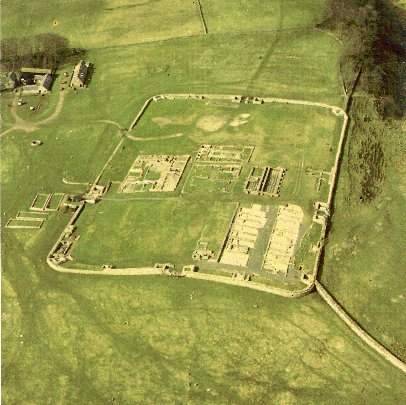 Housesteads Fort on Hadrian`s Wall was part of the defensive system built by the Romans against the Barbarians in the North. Its Roman name, it is thought, was Vercovicium, from a Celtic phrase that translates as "the place of the effective fighters," though others have put forward the alternative names Velurtion and Borcovicium, relating to high ground.The site, a sheltered location, was a favourable one as it had a stream nearby to provide a water supply, and was surrounded by fertile land.
Housesteads Fort on Hadrian`s Wall was part of the defensive system built by the Romans against the Barbarians in the North. Its Roman name, it is thought, was Vercovicium, from a Celtic phrase that translates as "the place of the effective fighters," though others have put forward the alternative names Velurtion and Borcovicium, relating to high ground.The site, a sheltered location, was a favourable one as it had a stream nearby to provide a water supply, and was surrounded by fertile land.
The barracks could accommodate around 800 men and, though this number varied, depending on circumstances, Housesteads was garrisoned right up to the end of the Roman occupation of Britain, around the 5th Century. These were mainly auxiliary soldiers recruited from subjugated peoples and, in AD 200, the troops stationed there seem to have been former residents of Tungria (Southern Belgium, Holland).
The photograph to the left is used with the kind permission of Airfotos Ltd. who can be contacted at AIRFOTOS
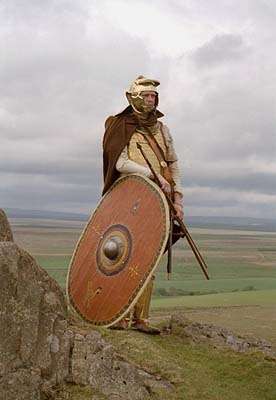
Fourth century legionary (re-enactment) |
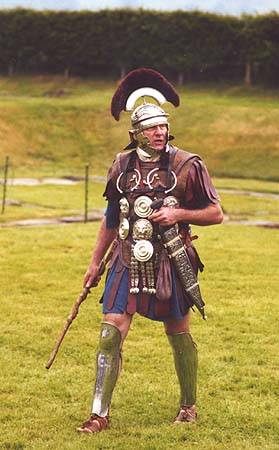
The Centurion
|
Inscriptions on altar stones
I O N MILITES LEG II AUG
(To Jupiter, Best and Greatest ,the soldiers of the 2nd Legion (dedicate this)
Inscriptions have revealed that Housesteads was occupied by soldiers of the 2nd Augustan Legion (Legio Secunda Augusta) and by soldiers of the 6th Legion:
LEGIO SEXTAE VICTRIX (The 6th Victorious Legion)
For a virtual tour of Housesteads Fort see: Housesteads Roman Fort Virtual Reality Tour
The photographs show re-enactment scenes at Hadrian`s Wall by various enthusiasts and are printed here with the kind permission of Franco and of Sion.
Maryemm
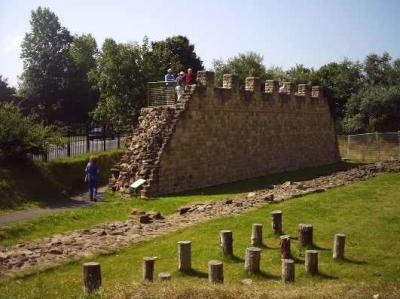
Taken in July, 2003, while on a tour of Roman Britain; this shows real ruins and reconstruction of part of the SEGUNDUNUM fort (Hadrian`s Wall). Posts are wood, put into postholes found during the
excavation,
Ralph Balzac
Page 11 ~ BOUDICA: WARRIOR QUEEN
ECCE II Contents





